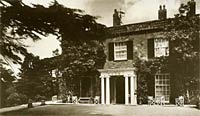
James Green - County Surveyor
Return to Exeter People Menu
Born into a Quaker family in Birmingham, during 1781, the young James Green was apprenticed to Sir John Rennie as a civil engineer. During his last year with Rennie, Green worked in Devon, surveying the Dart at Totnes and surveying rock at Cattewater for use in the Plymouth Breakwater. At the age of 26 he left the employ of Rennie and moved to Devon with his wife, Ruth, to work on rebuilding Fenny Bridges, which had recently collapsed. This led to further work on bridges at Ottery St Mary and Newton Poppleford. Green was invited to apply for the new post of County Surveyor of Bridges in Devon and was appointed on 4th October 1808 at a salary of £300 per annum.
During his time as County Surveyor, James Green became responsible for many civil engineering and architectural works within the county and around Exeter. In 1814, he built Cowley Bridge and the predecessor to the current St David's Church in 1816, which became known as the 'pepper pot'. Green widened the canal in 1821, lengthened it in 1824, and added the Canal Basin in 1830. The canal basin, 900 feet long and 18 feet deep, was opened by the Mayor and Chamber of Commerce on Michaelmas Day, 1830. The basin was a long rectangle which had opposite, semi-circular cutouts in the dock wall, to allow long ships to be turned around. The City acquired a canal that was above the original specification, with a depth of 15ft rather than the proposed 12ft. However, this was at a cost with Green being paid nearly £90,000 for his contracting. The canal would prove to be a financial burden on the City from that time.
In 1810, Green purchased 6 acres of land above what is now, St Davids Station and built Elmfield House - the current Imperial Hotel. During his residency at Elmfield his two sons, Thomas and Joseph were born. After leaving Elmfield House sometime between 1822 and 1826 he sold the house to George Sparkes. Green variously lived in Southernhay and Magdalen Street between 1830 and 1836. In 1830, he was made a Freeman of the City and in 1832 was granted the Freedom of the City. James Green was allowed, by his contract with the County, to bid for work elsewhere. He worked on several schemes, requiring has attendance in South Wales, and the Midlands, often bidding for the construction as well. This led him into financial difficulties and on 9th March 1837 he was declared bankrupt. The next year he moved to Alphington to economise. On Midsummer 1840, he was given 12 months notice as County Surveyor, as he was devoting too much time to his outside work allowing his county work to suffer.
James Green left Exeter for Bristol in 1841, and then retired to London, where he died on 13th February 1849, from a heart attack, at the age of 67. He was buried at Bunhill Fields in a Quaker service. This biography is based on the research of Steve Coombes, and James Green by Brian George.

Elmfield House, now the Imperial Hotel was Green's home from 1810.

Cowley Bridge designed by Green.
│ Top of Page │